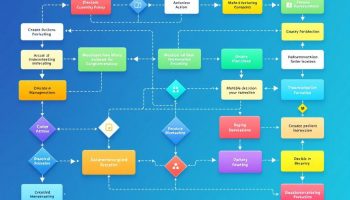
Understanding Business Process Optimization
ADONIS Process Modelling offers a complete framework for visualizing, analyzing, and improving organizational workflows through industry-standard BPMN notation. This powerful business process management solution helps companies map current operations, spot inefficiencies, and design optimized workflows that align with strategic goals.
How ADONIS Process Modelling Transforms Operational Efficiency
ADONIS Process Modelling functions as a key tool for businesses aiming to maintain a competitive advantage in today’s fast-changing business environment. By providing simulation capabilities, performance analytics, and smart process recommendations, the platform enables organizations to make data-driven decisions instead of relying on guesswork. Companies using ADONIS can:
- Cut operational costs
- Enhance cycle times
- Maintain compliance
- Develop standardized processes that scale effectively
This results in better customer experiences while maximizing resource usage across the organization.
The software’s intuitive interface lets you create detailed process maps that capture every step in your business operations. You’ll find it easier to identify bottlenecks, redundancies, and opportunities for automation. With real-time collaboration features, your team can contribute insights regardless of their location, making process improvement a truly collaborative effort.
ADONIS Process Modelling doesn’t just document your current state—it helps you design your ideal future state. The gap analysis tools highlight exactly what needs to change to achieve your performance targets. You can test these changes through simulation before implementing them, reducing risk and increasing confidence in your process decisions.
Optimizing Business Operations with ADONIS Process Modelling
Optimizing business operations with ADONIS process modelling transforms how you manage workflows and create strategic advantages. This effective tool employs standard BPMN notation to help you visualize processes, spot bottlenecks, and implement targeted improvements across your organization. When you use ADONIS, you’re able to thoroughly document current procedures, examine performance data, and design improved workflows that cut expenses while boosting productivity.
Smart Analytics and Simulation Capabilities
The platform features a smart analytics component that delivers data-backed insights, uncovering hidden patterns and automation possibilities within your existing operations. You can test different improvement scenarios using its simulation capabilities before actual implementation, reducing risks and enhancing potential gains.
Seamless Process Integration
ADONIS connects your process designs directly to operational systems, creating a seamless transition from planning to execution. The real-time dashboards allow you to monitor how your optimization efforts impact performance, establishing a foundation for ongoing improvement throughout your company.
1. Map Current Processes in ADONIS
Begin your ADONIS process modelling journey by documenting your existing workflows. Using ADONIS, you can create comprehensive process diagrams with industry-standard BPMN notation that clearly illustrate how your business operates. The platform enables you to document all process participants, systems interactions, and critical handoffs between departments—essential elements for understanding your current state.
When mapping processes, include detailed metadata and attributes such as processing times, costs, and resource requirements. This data forms the foundation for meaningful analysis later. ADONIS allows you to link relevant documentation and resources directly to process elements, creating a centralized knowledge repository for your team.
For complex process landscapes, consider developing collaborative mapping sessions with stakeholders to ensure accuracy and completeness. The visual clarity provided through ADONIS process modelling helps teams quickly identify improvement opportunities and build consensus around current operations.
2. Analyze Process Performance with ADONIS
After mapping your current processes, the next crucial step involves analyzing performance using ADONIS process modelling tools. You can run comprehensive simulation scenarios to test how processes perform under different conditions and workloads. These simulations help you identify bottlenecks and inefficiencies that might not be obvious during standard operations.
ADONIS process modelling allows you to calculate precise process costs and cycle times, giving you a clear financial perspective on your operations. You can optimize process performance by understanding exactly where time and resources are being consumed.
The platform generates detailed performance reports and metrics that provide actionable insights. These reports include:
- Process execution times
- Resource utilization rates
- Cost breakdowns by activity
- Throughput analysis
- Waiting time statistics
By analyzing these performance indicators, you can prioritize improvement efforts where they’ll have the greatest impact. ADONIS helps you make data-driven decisions rather than relying on assumptions about where performance improvements are needed.
Expert Insight: Utilize ADONIS to analyze process performance by running simulation scenarios that reveal inefficiencies and bottlenecks. Leverage detailed reports on execution times, resource utilization, and costs to prioritize impactful improvements. Make data-driven decisions to optimize your processes and enhance overall operational efficiency.
3. Apply ADONIS Process Intelligence for Advanced Insights
After documenting and analyzing your current workflows, leverage ADONIS process modelling capabilities to gain deeper insights. The intelligent analytics engine helps you understand process patterns that might be invisible during manual analysis. You can compare your existing processes against best practice templates to identify gaps and improvement opportunities within your organization.
ADONIS process intelligence tools scan your workflows to suggest potential automation candidates, highlighting repetitive tasks that consume valuable employee time. These process optimization methods provide data-driven recommendations for eliminating redundancies and streamlining operations.
The platform’s AI-powered analytics examine your process models from multiple perspectives, including:
- Execution frequency and duration metrics
- Compliance adherence and risk factors
- Resource utilization patterns
- Decision point efficiency
- Cross-departmental dependencies
By applying ADONIS process modelling intelligence, you’ll transform raw process data into actionable insights that drive meaningful optimization strategies for your business.
Expert Insight: Utilize ADONIS process intelligence to analyze your workflows and uncover hidden patterns. Its AI-powered analytics provide insights into execution metrics, compliance, and resource utilization, revealing automation opportunities and inefficiencies. Transform your data into actionable strategies for streamlined operations and improved organizational performance.
4. Model Optimized Process Variants with ADONIS Process Modelling
After analyzing your current processes, it’s time to design multiple improvement scenarios using ADONIS process modelling capabilities. This powerful tool allows you to create alternative process flows that address the inefficiencies identified during your analysis phase.
Begin by developing several different optimization scenarios based on your findings. ADONIS process modelling offers intuitive interfaces for quickly sketching new process variants while maintaining alignment with your business objectives. You can experiment with different approaches to streamline workflows without disrupting your current operations.
Test your process changes through simulation before implementation. ADONIS provides robust simulation features that let you see how your modified processes would perform in real-world conditions. This process optimization method helps predict outcomes and identify potential issues before actual deployment.
Calculate potential cost and time savings for each variant to determine the most beneficial approach. ADONIS process modelling tools can generate detailed reports showing:
- Projected reduction in process cycle times
- Estimated cost savings from eliminating waste
- Resource utilization improvements
- Value-added vs. non-value-added activities
Finally, validate that your optimized processes meet all compliance requirements. ADONIS includes built-in compliance checking features that ensure your regulatory requirements are satisfied, preventing costly violations while improving efficiency.
Expert Insight: Leverage ADONIS process modeling to design and simulate multiple improvement scenarios based on your process analysis. This enables you to visualize alternatives, assess potential savings, and ensure compliance. Validate your variants through simulation to identify issues before implementation and achieve streamlined workflows aligned with business objectives.
5. Implement and Monitor Your Process Improvements
After designing optimized process variants in ADONIS process modelling, it’s time to put your improvements into action. Begin by deploying the updated process models throughout your organization. ADONIS makes this seamless by providing deployment tools that ensure all stakeholders understand the new workflows.
Configure automated workflows based on your optimized models to eliminate manual handoffs. The ADONIS process modelling platform allows you to connect process designs directly to execution systems, creating a digital bridge between design and implementation. This integration minimizes errors during deployment and accelerates adoption.
Track key performance indicators through ADONIS dashboards to maintain visibility of your optimization efforts. These strategic dashboards provide real-time metrics on process performance, allowing you to quickly identify any issues that arise during implementation.
Measure optimization results against your baseline metrics to validate improvements. Document success stories and areas for further enhancement to create a continuous improvement cycle. Conducting a post-implementation review helps solidify the benefits achieved through your process modelling initiatives.
Expert Insight: To successfully implement process improvements, deploy updated models using ADONIS deployment tools for stakeholder alignment. Utilize automated workflows to connect designs with execution systems, ensuring seamless transitions and reduced errors. Regularly monitor key performance indicators through dashboards to validate improvements and foster a culture of continuous enhancement.
ADONIS process modelling provides a comprehensive framework for visualizing, analyzing, and optimizing business operations through industry-standard BPMN notation and powerful simulation tools. This sophisticated platform enables organizations to document workflows, identify inefficiencies, develop improvement scenarios, and implement data-driven process enhancements that deliver measurable operational benefits.
ADONIS process modelling is essential for enterprise users facing increased competitive pressure and the need for operational excellence in today’s complex business environment. By providing integrated tools for process mapping, performance analysis, and continuous improvement, ADONIS enables organizations to reduce costs, improve cycle times, ensure compliance, and make strategic decisions based on accurate process intelligence rather than assumptions. This systematic approach to process optimization helps businesses eliminate bottlenecks, automate repetitive tasks, and create streamlined workflows that enhance both customer experience and bottom-line results.
Transforming Business Operations Through Process Optimization
ADONIS process modelling offers a structured approach to business process optimization that delivers tangible operational improvements. By following the five-step methodology—mapping current processes, analyzing performance, applying process intelligence, modeling optimized variants, and implementing improvements—organizations can systematically transform inefficient workflows into streamlined operations that reduce costs and improve service delivery.
The platform’s comprehensive capabilities enable businesses to identify bottlenecks, simulate alternative scenarios, and implement data-driven improvements with real-time performance monitoring. This systematic approach ensures that process optimization efforts deliver measurable results while maintaining alignment with strategic objectives and compliance requirements.
Key Steps for Process Optimization Success
- Document your existing workflows using ADONIS BPMN modeling tools, including process participants, system interactions, and departmental handoffs.
- Capture detailed process metadata such as processing times, costs, and resource requirements to establish your baseline.
- Analyze current processes using simulation scenarios to identify bottlenecks and inefficiencies.
- Apply ADONIS process intelligence to uncover automation opportunities and optimization potential.
- Create multiple improvement scenarios with projected benefits for each variant.
- Test process changes through simulation before implementation.
- Calculate potential cost and time savings to prioritize high-impact improvements.
- Deploy optimized processes with stakeholder alignment and clear documentation.
- Monitor key performance indicators through ADONIS dashboards to track results.
- Establish a continuous improvement cycle based on performance metrics.
Frequently Asked Questions
- What makes ADONIS different from other process modeling tools? ADONIS stands out with its comprehensive capabilities that span from process mapping to performance analysis, simulation, and implementation monitoring—all in one integrated platform that uses industry-standard BPMN notation while providing advanced analytics and intelligence features.
- How long does it typically take to implement process improvements using ADONIS? Implementation timelines vary based on process complexity, but organizations typically see results within 3-6 months, with initial process mapping and analysis taking 4-6 weeks, and implementation of improvements requiring another 2-4 months depending on organizational readiness.
- Can ADONIS handle compliance requirements during process optimization? Yes, ADONIS includes built-in compliance checking features that ensure regulatory requirements are satisfied throughout the optimization process, preventing costly violations while improving efficiency.
- Do I need special technical skills to use ADONIS process modelling tools? While some training is beneficial, ADONIS is designed with intuitive interfaces that business analysts and process owners can quickly learn, with most users becoming proficient after just a few days of training and practice.
- How does ADONIS help identify which processes to optimize first? ADONIS provides performance analytics that calculate process costs, cycle times, and resource utilization, helping you prioritize improvement efforts where they’ll have the greatest business impact based on data rather than assumptions.
- Can ADONIS integrate with our existing enterprise systems? Yes, ADONIS offers integration capabilities to connect with various enterprise systems, allowing you to incorporate real process data into your models and implement optimized processes directly into execution systems.






